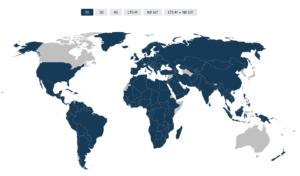A Comparison: Cellular vs WiFi for IoT
The Internet of Things (IoT) is transforming our world. From smart homes to industrial automation, IoT devices are everywhere.Yet, the success of these devices hinges on one critical factor: connectivity.
In the realm of IoT, two connectivity options often come to the forefront: Cellular and WiFi. Each has its strengths and weaknesses, making the choice between them a complex decision. This article aims to simplify that decision. We will delve into a comprehensive comparison of Cellular vs WiFi connectivity for IoT. We will explore their nuances, benefits, and limitations. Our goal is to equip you with the knowledge to make informed decisions for your IoT projects.
Whether you’re an IoT developer, a decision-maker in an enterprise, or a technology enthusiast, this guide is for you. We will cover everything from data transmission rates to security features, from cost analysis to scalability potential. By the end of this guide, you’ll have a clear understanding of Cellular vs WiFi for IoT.
Content
- Understanding IoT Connectivity
- Cellular IoT Connectivity Explained
- WiFi in the World of IoT
- Coverage Comparison: Cellular vs WiFi
- Data Transmission Rates: A Critical Factor
- Reliability and Stability in Different Environments
- Power Consumption Profiles for IoT Devices
- Scalability in IoT Deployments
- Security Features and Vulnerabilities
- Cost Analysis: Initial Setup and Operational Expenses
- Network Latency and IoT Applications
- Use Cases: Finding the Right Fit for Cellular and WiFi
- The Future of IoT Connectivity
- Conclusion: Making an Informed Decision for IoT Connectivity
Understanding IoT Connectivity
IoT connectivity is the backbone of any IoT system. It enables devices to communicate with each other and with the cloud. Without reliable connectivity, the data generated by IoT devices cannot be effectively utilized. Thus, choosing the right connectivity solution is crucial for the success of any IoT project.
The Role of Connectivity in IoT Ecosystems
In an IoT ecosystem, connectivity plays a pivotal role. It facilitates the seamless exchange of data between devices and systems. This data exchange is what allows for the automation and intelligence that define IoT. Connectivity also impacts the performance, reliability, and security of an IoT system. Therefore, understanding the different connectivity options and their implications is essential for anyone involved in IoT.
Learn more about IoT Connectivity by reading the Guide below.
Defining Cellular and WiFi Connectivity
Cellular and WiFi are two of the most common connectivity options for IoT.
Cellular connectivity leverages the same networks used by mobile phones, offering wide coverage and high reliability. On the other hand, WiFi provides a cost-effective solution for short-range connectivity, often used in home and office environments. Both have their unique advantages and challenges, which we will explore in this guide.
Cellular IoT Connectivity Explained
Cellular connectivity for IoT leverages existing mobile networks. It provides wide-area coverage and high-speed data transmission. Cellular IoT connectivity is ideal for applications that require real-time data exchange over long distances. It is also highly reliable, making it suitable for mission-critical IoT applications.
Advancements in Cellular Technology: 4G, LTE, 5G, and LPWAN
Cellular technology has evolved significantly over the years. 4G and LTE networks offer high-speed data transmission, supporting a wide range of IoT applications. 5G, the latest generation of cellular technology, promises even higher speeds, lower latency, and increased device density.
Low-Power Wide-Area Networks (LPWAN), such as NB-IoT and LTE-M, provide energy-efficient connectivity for IoT devices that transmit small amounts of data over long distances.
WiFi in the World of IoT

WiFi is a popular choice for IoT connectivity within confined spaces. It provides high-speed data transmission over short distances. WiFi is ideal for applications that require high data rates and low latency within a limited coverage area. It is commonly used in smart home applications, where multiple IoT devices are interconnected within a single network.
The Evolution and Application of WiFi Technology
WiFi technology has seen significant advancements over the years. The latest WiFi 6 standard offers higher data rates, increased device capacity, and improved power efficiency. WiFi is easy to deploy and manage, making it a convenient choice for many IoT applications. However, its limited range and susceptibility to interference can pose challenges in certain environments.
Coverage Comparison: Cellular vs WiFi
When it comes to coverage, Cellular and WiFi offer distinct advantages.
Cellular networks provide wide-area coverage, making them suitable for IoT applications spread over large geographical areas. On the other hand, WiFi offers localized coverage, ideal for IoT devices operating within a confined space.
Analyzing Coverage Areas and Limitations
Cellular networks leverage existing mobile infrastructure to provide extensive coverage. This makes Cellular a viable option for IoT applications that require connectivity across cities, regions, or even countries.
However, WiFi, with its limited range, is best suited for applications within homes, offices, or specific indoor environments.

Data Transmission Rates: A Critical Factor
Data transmission rates are a crucial factor in IoT connectivity. The choice between Cellular and WiFi often hinges on the speed requirements of the IoT application. Both technologies have evolved significantly, offering high-speed data transmission capabilities.
Cellular vs WiFi: Speeds and Throughput
Cellular networks, especially with the advent of 5G, can deliver high-speed data transmission. This makes Cellular suitable for IoT applications that require real-time data exchange or streaming of high-definition content.
WiFi, on the other hand, provides high-speed connectivity within a localized area, making it ideal for applications like smart homes where multiple devices need to communicate simultaneously.
Reliability and Stability in Different Environments
Reliability and stability are paramount in IoT connectivity. The choice between Cellular and WiFi often depends on the environment where the IoT devices will be deployed. Both technologies have their strengths and weaknesses when it comes to performance under different conditions.
Network Performance Under Various Conditions
Cellular networks are generally more reliable in outdoor environments and over long distances.
They can maintain connectivity even in remote areas, making them suitable for IoT applications like fleet tracking or remote monitoring.
WiFi, however, performs better in indoor environments, providing stable connectivity within a localized area. This makes it ideal for smart home applications where multiple devices need to communicate within a confined space.
Power Consumption Profiles for IoT Devices
Power consumption is a critical factor in IoT connectivity. The choice between Cellular and WiFi can significantly impact the battery life of IoT devices. Understanding the power consumption profiles of these technologies can help in designing more energy-efficient IoT solutions.
Comparing the Energy Efficiency of Cellular and WiFi
Cellular IoT devices tend to consume more power due to the high energy requirements of maintaining a connection over long distances. This can be a challenge for battery-powered IoT devices deployed in remote areas.
On the other hand, WiFi devices generally consume less power, making them more suitable for applications where devices are powered continuously or have access to regular charging. However, the power consumption of WiFi can increase significantly with the number of connected devices and network traffic.
Scalability in IoT Deployments
Scalability is a key consideration in IoT deployments. The ability to add more devices to the network without compromising performance is crucial. Both Cellular and WiFi offer different scalability potentials, each with its own set of advantages and challenges.
Cellular vs WiFi: Scaling Up Your IoT Project
Cellular networks, with their wide coverage and dedicated spectrum, can support a large number of IoT devices. This makes Cellular a suitable choice for large-scale IoT deployments, especially in smart city applications. Read more on: Preparing for global IoT deployments
On the other hand, WiFi networks can struggle with scalability due to limited bandwidth and potential interference issues. However, with the advent of WiFi 6, the scalability of WiFi networks is set to improve, making it a viable option for high-density IoT applications.
Security Features and Vulnerabilities
Security is a paramount concern in IoT deployments. Both Cellular and WiFi networks have security features and vulnerabilities that need to be considered.
One key advantage of utilizing cellular IoT technology is the ability to establish a private Access Point Name (APN) for enhanced security measures. By creating a private APN, organizations can ensure that their IoT devices are operating within a closed network, reducing the risk of unauthorized access and potential security breaches.
Additionally, the use of fixed IP addresses for cellular IoT devices further enhances security by providing a stable and easily traceable connection. With these security features in place, businesses can have greater peace of mind knowing that their IoT infrastructure is safeguarded against potential threats.
Evaluating the Safety of Cellular and WiFi Networks
WiFi networks, on the other hand, offer robust security features such as WPA3 encryption. Yet, they are susceptible to attacks like WiFi phishing and network eavesdropping. Moreover, the security of a WiFi network largely depends on the user’s security practices, such as setting strong passwords and regularly updating firmware.
In conclusion, while both Cellular and WiFi have their own security strengths and weaknesses, the choice between the two should be guided by the specific security requirements of the IoT deployment.
Cost Analysis: Initial Setup and Operational Expenses
The cost of IoT connectivity is a critical factor in the decision-making process. It includes both the initial setup cost and the ongoing operational expenses.Cellular connectivity, for instance, often involves higher setup costs due to the need for SIM cards and data plans.
The Price of Connectivity: Cellular vs WiFi
On the other hand, WiFi connectivity typically requires a one-time investment in a router and internet service. However, the operational costs can vary depending on the internet service provider and the data usage.
In conclusion, while Cellular connectivity may have higher initial costs, WiFi can potentially lead to higher operational expenses. Therefore, the choice between Cellular and WiFi should be based on a thorough cost-benefit analysis considering both the initial and ongoing costs.
Network Latency and IoT Applications
Network latency is a crucial aspect of IoT connectivity. It refers to the time it takes for data to travel from one point to another in a network. In IoT applications, low latency can significantly enhance the user experience and the efficiency of operations.
How Cellular and WiFi Compare in Response Times
Cellular networks, especially 5G, are designed to offer low latency. This makes them suitable for IoT applications that require real-time data transmission, such as autonomous vehicles and telemedicine.
On the other hand, WiFi networks may experience higher latency due to congestion and interference. However, advancements in WiFi technology, such as WiFi 6, are aimed at reducing latency and improving performance. Therefore, the choice between Cellular and WiFi should consider the latency requirements of the specific IoT application.
Use Cases: Finding the Right Fit for Cellular and WiFi
The choice between Cellular and WiFi for IoT connectivity often depends on the specific use case. Different IoT applications have unique requirements that may make one connectivity option more suitable than the other. For instance, IoT devices in remote or rural areas may benefit more from Cellular connectivity due to its wider coverage.
On the other hand, IoT devices in a home or office environment may find WiFi more suitable due to its high data rates and low cost.
Matching Connectivity Options to IoT Scenarios
Consider an IoT application in the healthcare sector, such as remote patient monitoring. This application requires reliable, continuous connectivity and low latency, which Cellular networks can provide.
On the other hand, a smart home application with multiple IoT devices may benefit from WiFi’s high data rates and ease of deployment.
Therefore, understanding the specific needs of your IoT scenario is crucial in choosing between Cellular and WiFi.
The Future of IoT Connectivity
The future of IoT connectivity is set to be shaped by several emerging technologies and trends. The advent of 5G and WiFi 6, for instance, promises to revolutionize IoT connectivity with higher data rates, lower latency, and increased device density. Moreover, the integration of AI and machine learning can enhance network management and optimize IoT connectivity solutions.
Emerging Technologies and Trends in Connectivity Solutions
One significant trend is the rise of Low-Power Wide-Area Networks (LPWAN) for IoT applications requiring low power consumption and long-range connectivity.
Another trend is the use of edge computing to reduce latency and enhance the performance of IoT devices.
Furthermore, the potential for blockchain technology to secure IoT connectivity transactions and the role of digital twins in simulating and testing IoT connectivity scenarios are also promising developments in the IoT connectivity landscape.
Conclusion: Making an Informed Decision for IoT Connectivity
Choosing the right connectivity solution for your IoT project is a critical decision.
It requires a thorough understanding of the specific requirements of your IoT application, the capabilities and limitations of different connectivity options, and the future trends in IoT connectivity.
Summary of Key Considerations in Choosing Cellular vs WiFi
In summary, Cellular and WiFi each have their strengths and weaknesses.
Cellular offers broader coverage, higher reliability, and better scalability, making it suitable for large-scale, mission-critical IoT applications.
On the other hand, WiFi provides higher data rates, lower latency, and easier deployment, making it ideal for small-scale, high-throughput IoT applications.
Therefore, the choice between Cellular and WiFi should be based on a careful evaluation of your IoT project’s needs, the total cost of ownership, and the potential for future scalability and security.
Are you looking for Cellular IoT Connectivity for your global IoT deployment? Learn more about Velos IoT Connectivity Solutions.
Want to know more? Get in touch.
Whether it is a global IoT deployment or a local project, our connectivity solutions are designed to give you the flexibility to scale your business. Contact us to find out how our experts can help


